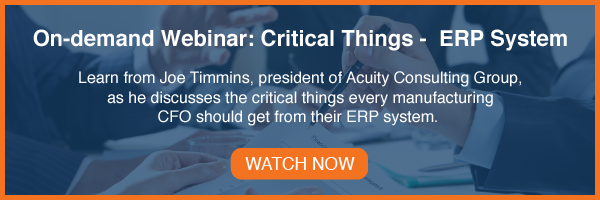Want an ERP Project to Succeed in Your Company? Do a Checkup on Your Users.
You’ve decided to implement an enterprise resource planning (ERP) system. This is a significant project, and its success requires cooperation from every user in your business. For example, you won’t get a budget without your company owner, and the software won’t “stick” if your employees fight it.
What is employee buy-in?
“Buy-in” is when employees accept a project and are willing to make it succeed.
If you have employee buy-in in your organization, people are committed to your mission/goals and find their daily work meaningful. This buy-in promotes employee engagement and increases the likelihood employees will go ‘the extra mile.’
Don’t underestimate getting buy-in.
What if you don’t have employee buy-in?
There are many reasons for a lack of employee buy-in, including:
- Fear of the unknown
- Dislike of having to re-learn their jobs
- Benefits of the new system may not “benefit” them
It’s human nature to dislike change, so don’t be surprised if you encounter resistance.
Try these ideas to make it easier for employees.
Get their input
Employees want to feel acknowledged, so gather their input! Ask them which of their operations/daily tasks cause struggles. Ask them about system problems as they go about their jobs. Hearing, listening, and utilizing employees’ input will increase their ERP ownership and contribute to better results.
Communicate
People, at all levels, like to know why. If employees understand the reasons behind the change, they’re more likely to get on board. Sometimes an ERP system is for purposes from which users are removed (e.g., FDA compliance and EDI requirements). These reasons may rock their part of the supply chain. Have a conversation about compelling business reasons. It will help. Not having that conversation will hurt.
In other cases, the ERP will benefit them. Explain the features that will make their jobs easier and will improve business performance. Overall, the ERP was chosen to lead to a more competitive company and better job security. If that’s not your perspective, you’ve chosen the wrong ERP.
Have a plan
After announcing the choice of a new system, your employees will want to know how it will happen. Facilitating a successful ERP implementation requires thorough planning – share that planning with your employees. Use your value-added reseller (VAR), not the software company, to communicate the plan.
Require training
User adoption is critical – your system will fail if your employees refuse to use it. People have routines. They’ve done their jobs for years, and even though new software might make their jobs easier, they may still resist change. You can prevent this by providing VAR training to ensure users feel comfortable with the system and can navigate it to handle their daily tasks.
Make an honest assessment of users
Many transactional parts of ERP systems follow proven methods. Others take advantage of common principles that require skill sets. Even though software comes with planning tools like MRP, it can’t “APICs certify” your users. It won’t turn a shift leader who makes time entries into a cost accountant. Work with your VAR to understand base knowledge, both current and required, of all users, and plan accordingly.
Letting go of employees who refuse to buy in is an option, but it’s a poor business practice – you don’t want employee buy-in to come from fear. Instead, you want to inspire employees to take up the company vision and move forward with you in this new strategy.
At Acuity, we can help you get user buy-in and complete a successful ERP implementation. Contact us for more information.



